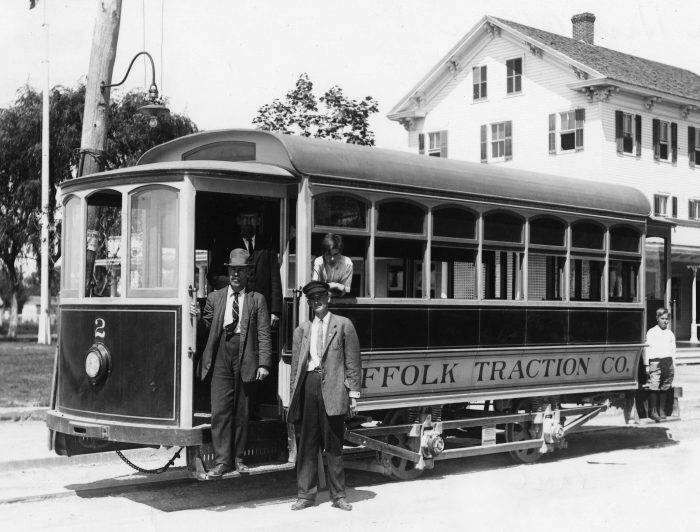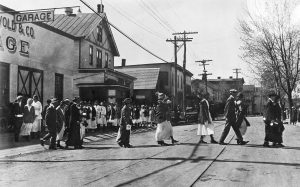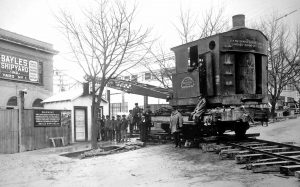Hometown History: From Sound to Bay — Port Jefferson and the Cross Island Trolley

Port Jefferson was not immune to the trolley fever that swept the United States during the late 19th century.
Orange T. Fanning, Thomas O’Donnell, Charles E. Tooker and other prominent village businessmen met in 1895 and called for the construction of an electric trolley line that would cross Long Island from Port Jefferson on the Sound to Patchogue on the Great South Bay.
According to its supporters, the proposed trolley would provide a connection with the Port Jefferson ferry that sailed to Bridgeport, Connecticut; increase tourism among day-trippers; and carry passengers from the Sound to the Bay in less than one hour.
The project’s cheerleaders also claimed the trolley would enrich property owners along the line and improve transportation by intersecting with the LIRR’s stations at Patchogue, Waverly (Holtsville) and Port Jefferson.

Seeing enormous profits in the trolley venture, parties from Long Island, New York City and Bridgeport organized the Patchogue and Port Jefferson Traction Company on Jan. 29, 1896.
Port Jefferson Traction announced that its 14-mile trolley road would be finished and in operation by April 1, 1903, but several factors kept the project from moving ahead.
Confronted by the high costs of equipment and materials, the corporation delayed work waiting for prices to fall. Word that New Haven, Connecticut, might run a steamboat to Port Jefferson and link with the trolley worried investors in Bridgeport who had backed Port Jefferson Traction’s scheme.
Arguments also arose over the trolley’s hours of operation, rate of speed, type of roadbed and method of power. The streetcar’s proponents quarreled over whether the line should be built from Patchogue to Port Jefferson or vice versa.
Mired in endless trolley talk, Port Jefferson Traction was acquired by the Central Long Island Electric Light and Railroad Company. Chartered on Dec. 17, 1903, the new corporation amended the proposed Patchogue-Port Jefferson route to include a Setauket-Stony Brook branch line. The organization also sought to build a power plant in Port Jefferson and develop land in an envisioned “Jefferson Manor” section of Echo.
Notwithstanding its glowing prospectus, Central Long Island never ran a streetcar in Port Jefferson, opening the door for the Suffolk Traction Company and its plans for a Cross Island trolley road.
Incorporated on June 27, 1906, Suffolk Traction soon became embroiled in legal disputes with its competitors over franchises, the LIRR over grade crossings and property owners over condemnation proceedings.
When the court battles finally ended and construction actually began, Suffolk Traction diverted resources that had been earmarked for Port Jefferson to expanding service on the South Shore. As a result, track was not laid along Port Jefferson’s Main Street (Route 25A) until 1909-13, but by then it was too late. Even discounting the years lost to inactivity and sporadic work, the trolley plan was already doomed in the village.

Automobiles were revolutionizing travel, giving Long Islanders the freedom to explore the open road and making them less dependent on public transit. In addition, Suffolk Traction was facing competition from faster buses that carried passengers between Port Jefferson and Patchogue on the “Auto Trolley Line.”
While managing to run a battery-powered streetcar between Patchogue and Holtsville, a bankrupt Suffolk Traction ceased operations in 1919.
Although the trolley never ran in Port Jefferson, the existing tracks were supplemented by temporary rails and used during World War I to move a self-propelled crane downhill from Port Jefferson’s LIRR station to Bayles Shipyard on the village’s waterfront.
The rusting trolley tracks, viewed as a nuisance by Port Jefferson’s motorists and pedestrians, were torn up as improvements were made along Route 25A, although rails were still visible at the foot of the village’s Main Street as late as September 1956.
Kenneth Brady has served as the Port Jefferson Village Historian and president of the Port Jefferson Conservancy, as well as on the boards of the Suffolk County Historical Society, Greater Port Jefferson Arts Council and Port Jefferson Historical Society. He is a longtime resident of Port Jefferson.






